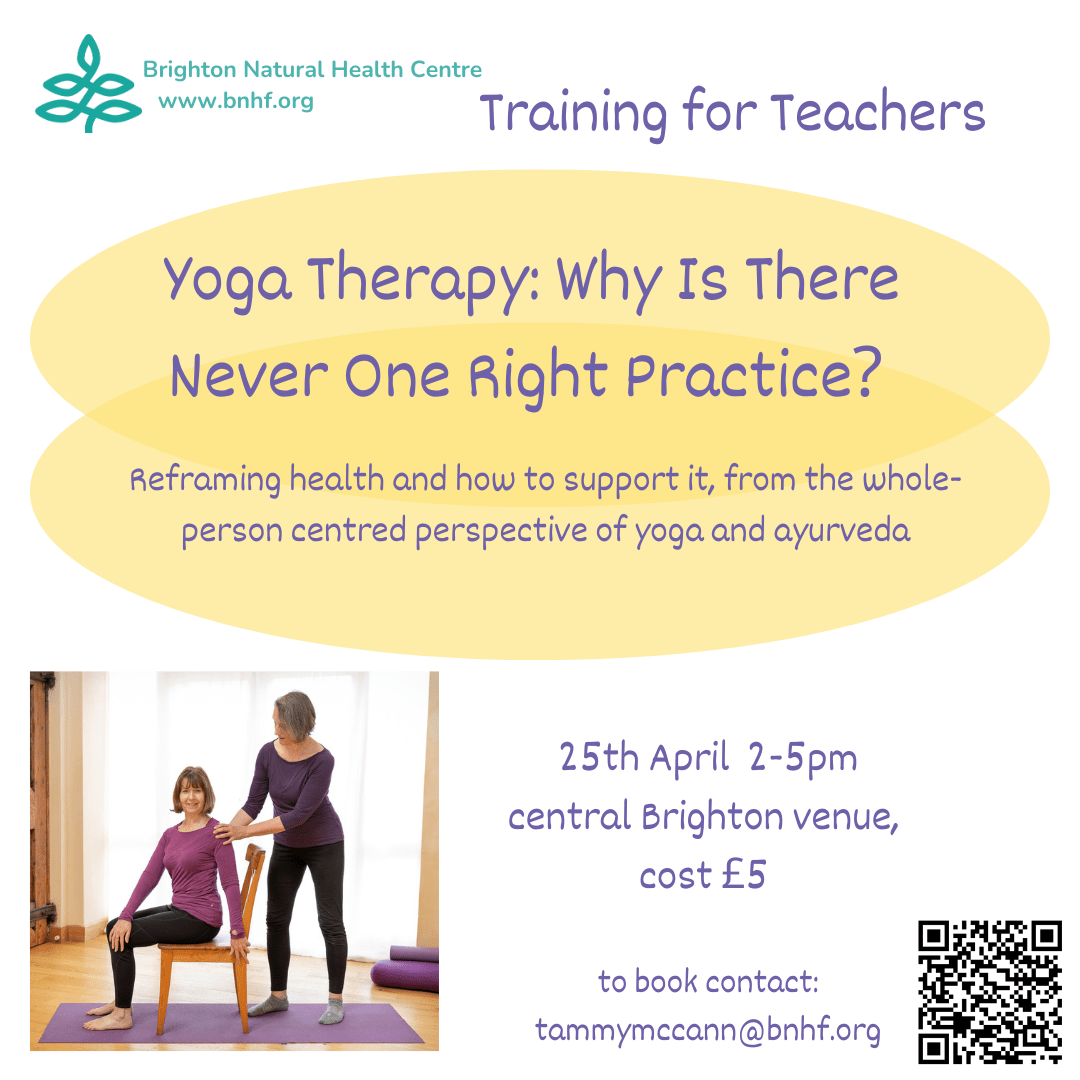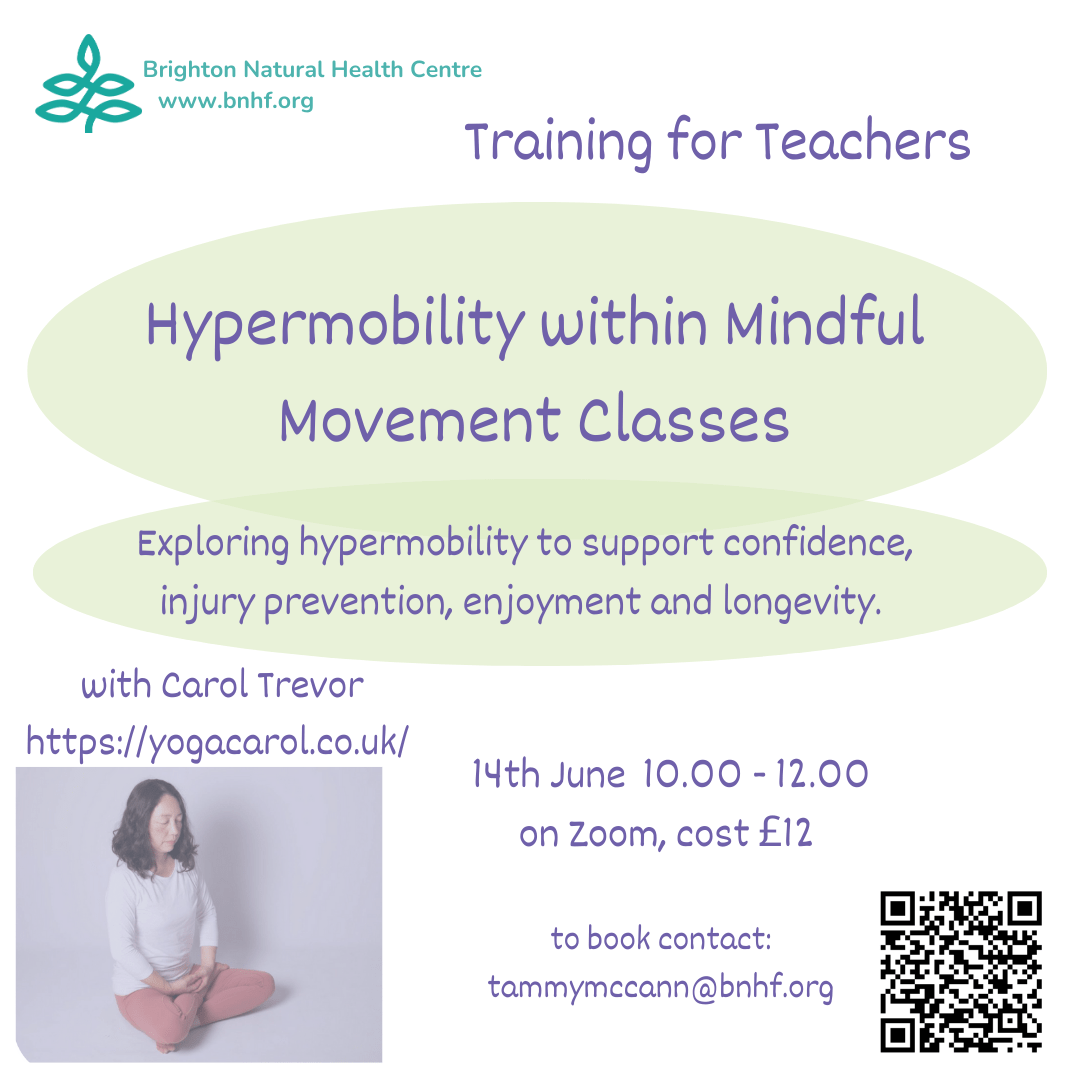Upcoming Training


Yoga Therapy: Why Is There Never One Right Practice?
As more and more people enjoy the overall health benefits of practising yoga in a group class, taking 1:1 lessons is also becoming popular. Providing 1:1 yoga therapy for an individual seeking to address particular health conditions within the parameters of their personal life circumstances requires a significant step-change from our general everyday teaching. Booking here
This workshop will stimulate a reframing of health and how to support it, from the whole-person centred perspective of yoga and ayurveda. We will explore how practices can, and must, vary immensely, even when two people present with the same illness. If we are to sincerely meet an individual’s needs there is never one right practice! Instead of ‘prescription practices’ the practice will need to reflect the complexity of each individual. You will be led in an interactive session to skillfully build a person-appropriate practice, experience a practice and gain some fundamental insights into the creative and impactful work of experienced yoga therapists.
Please bring a mat and block/bolsters to sit on, pen and paper to make notes if you wish (comprehensive handouts will be provided at the end).
This event is run by:
Sabine Dahn combines her work as a yoga teacher and therapist with teaching ceramics and creating her own artwork. Trained within the Viniyoga tradition , she is a BWY CPD trainer covering a wide range of topics, including a particular focus on mental health. She has collaborated with MIND and developed her own Mental Health Yoga Programme.
Alongside her private practice, established in 2008, she has offered yoga therapy on the haematology, gynae-oncology and children’s oncology wards at the Royal Sussex Hospital, Brighton. She recently drew up a programme of yoga for health promotion courses within the Learning for Health & Wellbeing section of Aspire Sussex Adult Education.
Barbara Dancer has run a yoga therapy practice since 2007, is on the committee for the British Council for Yoga Therapy (BCYT) and has been a Course Assessor for BCYT Accreditation.
She was Chair of BCYT between 2013-2016, working on the Core Curriculum as the basis for accreditation of UK yoga therapy training. She has taught yoga therapy privately, within the charity sector, in complementary health settings and within a publicly funded project.
“I enjoy working with people, providing tailored support and empowering them to improve their health. It’s fascinating and extremely rewarding work. On a larger scale, I would like to see yoga therapy “coming of age” and being part of community-based healthcare offering the important approaches of person-centred care and more involvement in one’s own health.’
Hypermobility within Mindful Movement Classes
Are you a Mindful Movement Teacher and would like to explore some of the practicalities of how to support students with hypermobility?
We are delighted to have experienced teacher and trainer Carol Trevor https://yogacarol.co.uk/ to hold this session.
Do you have ‘locked’ knees and elbow joints? Hands that easily touch the floor in standing forward bends? Some difficulty with spatial awareness and/or co-ordination? A feeling of stiffness or aches and pains, despite your flexibility? Shallow breathing, headaches or digestive issues?
Many yoga teachers and students have a degree of hypermobility, often without being aware of it. At some point however, there can be a sense that something is not quite right.
The experience and impact of joints that move beyond the average range of motion sits on a broad spectrum and can vary greatly from individual to individual. Hypermobility can be asymptomatic and even seem advantageous, at least initially, in the case of yoga or physical practice. It can also be debilitating.
An understanding of hypermobility is helpful if not essential for all yoga teachers. An informed approach supports confidence, injury prevention, enjoyment and longevity – on and off the mat – as well as a harmonious teacher-student relationship.
If you have any queries, please contact Tammy McCann: tammymccann@bnhf.org book here: Booking for teacher training.
Want to know about future training?
Email Tammy to be included in the mail out for future training.
Past Training
Neurodiversity and Mindful Movement
This CPD session with Carol Trevor https://yogacarol.co.uk/ explored some of the practicalities of how the lived experiences of neurodiversity (includingAD(H)D, dyslexia, autism, dyscalculia and dyspraxia) are best placed to inform our teaching approach. And explored the question - Why can mindful movement be so helpful and what is problematic?
Discover too how the unique needs, gifts and challenges of these populations elevate our teaching skills and outlook overall, and often for the benefit of the whole class
Gabi Parkham hosted recent training:
Welcome LGBTQIA+ people into your Mindful Movement Classes
this included:
- How to better support Lesbian, Gay, Bisexual, Pansexual, Transgender, Non-Binary, Intersex, Asexual, Queer and Questioning students in your classes/ studio
- The context of LGBTQIA+ experiences in the UK
- Your legal responsibility as a yoga teacher/ studio owner
- How to audit your classes/ studio to identify potential triggers for LGBTQIA+ people
- How to signpost your classes as welcoming for the LGBTQIA+ community
- How to set up LGBTQIA+ yoga classes and hold space for the LGBTQIA+ community
- How to be an ally for LGBTQIA+ people within your classes, studios, and community.
Racial Literacy Training:
Learn how to bring cultural sensitivity into your Yoga & Mindful Movement Classes
The word 'Yoga' is derived from the Sanskrit root 'Yuj', meaning 'to unite'. It is a spiritual practice, centred around ancient principles and philosophies to bring harmony, compassion, and authenticity into our lives.
Whilst yoga has an enriching foundation, the experiences shared by global majority individuals (Black, Asian, Minority Ethnic) often state incidents of racial bias and feelings of exclusion in yoga spaces.
Racial literacy is a set of practices designed to recognise, respond to and counter all forms of racial discrimination.
Sharing mindful movement through a trauma sensitive lens
This introduction to 'sharing mindful movement through a trauma sensitive lens’ in an opportunity for you to consider and explore ways in which you could make your teaching more trauma sensitive. The learning space is a collaborative space where participants are invited to bring their ideas and questions and learn together.
The learning objectives for the day are for you to:
1. Experience a short trauma sensitive practice
2. Name simple ways you can make make your classes more trauma sensitive
3. Understand why it is important for mindful movement teachers to be trauma aware
Teachers’ Resources
Video: 'Self-Regulating to Regulating Others'
Charlotte Watts talks about 'Self-Regulating to Regulating Others'
PDF: Regulation Inventory Resource
Regulation Inventory Resource Created by Dr Kristine Hickle and Chrissy Bulling with Charlotte Watts


